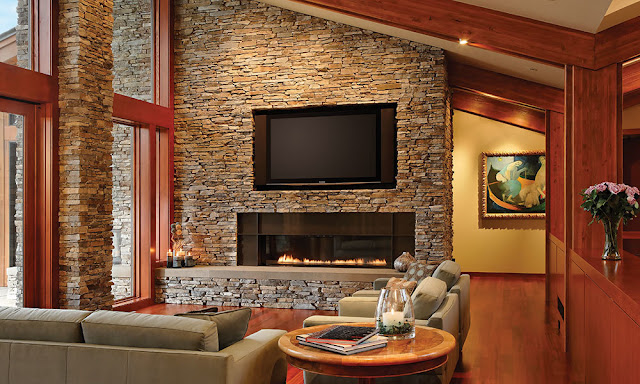Who doesn’t love the beauty of natural stone? Did you know you can often achieve the look and feel of natural stone more easily and cost effectively with manufactured stone veneer?
Whether you’re considering building an outdoor kitchen in your backyard, or you already have one that you want to upgrade, stack stone veneer will help you create a fabulous feature you can use for entertaining and family living. Unlike traditional structures built using natural stone, stack stone veneer is surprisingly easy to install and it is also an economical option.
Manufactured stone veneer is often as striking and beautiful as the natural stone it emulates. Also known as faux stone, manufactured stone veneer is a man made material designed to replicate the look of natural stone in a variety of architectural applications ranging from exterior façades to unique statement walls. Some stone veneer products offer such an array of shapes, sizes, and color gradations that even a trained eye can find it hard to determine the difference between faux and natural stone without close inspection.
Where Can You Use Manufactured Stone Veneer?
Architects and builders take advantage of the versatility and light weight of manufactured stone to employ it in many unique ways that move far beyond foundations and chimneys. One can install stone veneer over both metal and wood-framed walls, as well as over masonry substrates of CMU block or brick, and also over poured concrete, with proper installation procedures.
For builders looking to install manufactured stone veneer on fireplace facings and walls behind freestanding stoves, they can feel confident in Cultured Stone’s Class A fire rating with zero flame spread and zero smoke development—all properties that make faux stone comparable to natural stone in flame resistance.
If architectural plans call for stone placement in moisture-prone areas like walls near swimming pools or hot tubs, it’s a good idea to treat manufactured stone with a silane-based, non-film-forming, breather-type masonry sealer to increase its durability. When it comes to exposure to chemicals like chlorine, faux stone’s performance is similar to other types of concrete-based materials. Long-term chemical exposure can cause discoloration or fading. So if you’re using manufactured stone near pools or spas, be careful of spilling chemicals or other water treatments on the stone. If you do, be sure to hose them off immediately.
Cultured Stone’s products typically range from 8 to 12 pounds per square foot, so the product is significantly lighter than natural stone. And, unlike natural stone, one can install faux stone without any additional footings, foundations, or wall ties. This can substantially reduce installation time.
How Does Faux Stone Compare to Natural Stone?
In addition to its design versatility, manufactured stone veneer often costs a third to half what natural stone does for the same project. In the case of Cultured Stone, each piece is hand-colored with iron oxide pigments that help the stone veneer maintain the colors and nuance of natural stone for decades to come. With thousands of individual molds and a commitment to ensuring no two pieces of manufactured stone are colored alike, Cultured Stone veneer can exhibit much of the same variation in shape, size, texture, and color as natural stone.
Like natural stone, stone veneer is virtually maintenance-free. Home and building owners merely need to wash the surface occasionally to remove dust or dirt.
At one-third to half the cost of natural stone once installed, stone veneer can help architects and builders achieve cost efficiencies, while not sacrificing custom details. Manufactured stone also has a 2 percent waste factor versus a 10 percent or greater waste factor for natural stone.
Manufactured stone’s market share in the masonry industry is growing, given its design flexibility, speed of installation, and affordability. However, it’s important to understand that not all architectural stone products are of equal quality. Make sure to perform due diligence on the manufacturer before purchasing, paying careful attention to thickness, pattern repetitions, and coloration.
SKILLS REQUIRED FOR A DIY STONE VENEER PROJECT
The skills required for any DIY stone veneer project will depend on the materials and methods used for the job. For instance, if you opt to use natural stone cut for use as a veneer, you will need good building skills even if you don’t cut the stone to size yourself. If, on the other hand, you decide to use man-made stone veneer, it will be a lot easier and quicker to install. And if you choose to use Native Custom Stone’s ingenious Go-Stone Panels, you don’t need any special skills at all.
Generally, natural stone veneer is a job for the professionals. Because of the weight, it will require a foundation, and the cut-stone veneer units will have to be laid in mortar. Depending on the size of the stone used, it might even need steel reinforcing.
Manufactured stone is a lot easier to work with, and it doesn’t usually need any concrete foundation or base. Go-Stone panels are even lighter


